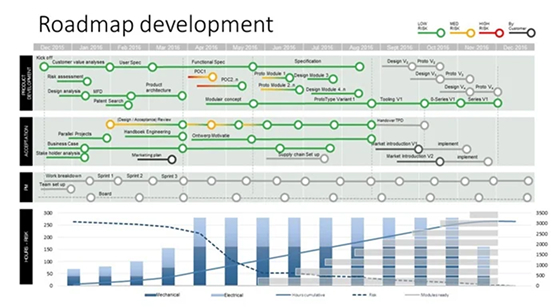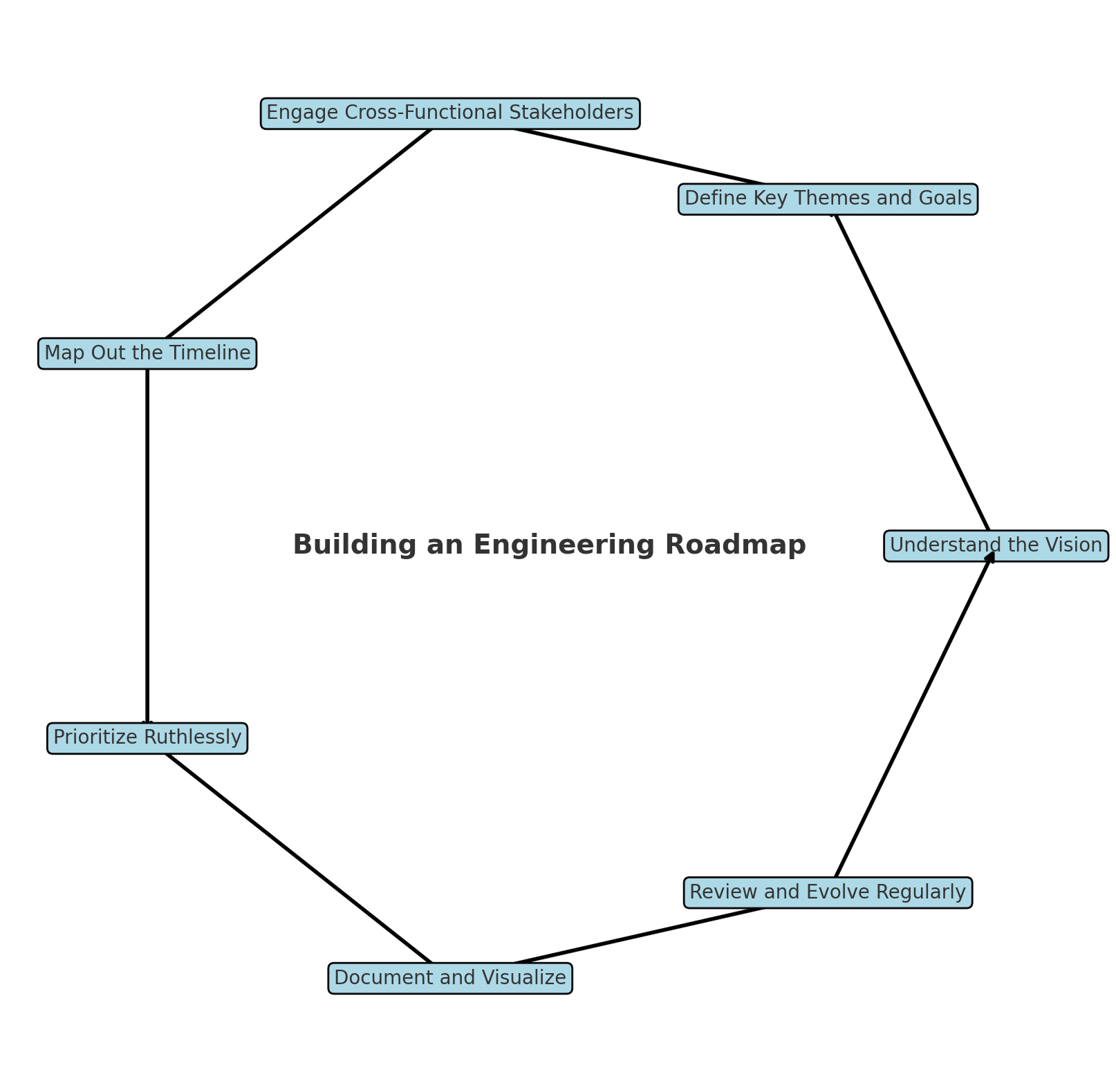If you’re building a feature, you know how the UI and API interact. However, it’s nice to see the bigger picture and understand how your feature adds value to the system and links with other components.
Well, this is what an engineering roadmap (development roadmap) does. It provides teams with the high-level view needed to ensure everyone knows where they’re going and how they’ll get there. It does this by showcasing a clear framework that outlines what to build and when. This helps teams prioritize effectively, identify issues, implement mitigation strategies in the foreseeable future, and deliver exceptional results.
So, in this article, let’s look at engineering roadmaps in greater detail and understand how you can build an engineering roadmap for your product.
What is an Engineering Roadmap?
Before going into detail, let us first look at an engineering roadmap:

Figure: An engineering roadmap
The figure above showcases an engineering roadmap. With an initial glance, you can see that it:
- Showcases what a team needs to do at certain points in time.
- Identifies deliverables (release candidates and proof of concepts) that need to be handed over.
That’s exactly what a platform engineering roadmap is: a visual or documented plan that outlines the short- and long-term direction of engineering initiatives. It aligns technical work with business objectives and lays out a timeline for implementing system architecture changes, infrastructure improvements, technical debt repayment, deliverables, and new features.
Roadmap vs. Planning
Many people often confuse the two terms roadmap and planning. From a holistic point of view, a roadmap also outlines the activities needed to be done for a project’s lifecycle. However, the two have different meanings.
In a nutshell, a software development roadmap communicates the vision of a project by highlighting the key elements and overall direction. It emphasizes risk reduction and stakeholder alignment. Planning, on the other hand, deals with execution, focusing on timelines, resource capacity, and quality delivery.
Product Roadmap vs. Engineering Roadmap vs. Technical Roadmap
Now, another aspect to look at is the three types of roadmaps:
- Product
- Engineering
- Technical
A product roadmap focuses on what features or functionalities will be delivered and when.
An engineering roadmap focuses on how technical teams will support product delivery and scalability.
A technical roadmap dives deeper into specific technologies, systems, and architecture decisions.
So, to sum it up, you can think of:
- An engineering roadmap is a tactical guide for a specific project for the engineering team to follow.
- A technical roadmap considers your tech stack strategy
- A product roadmap details your company’s product vision for wider audiences.
When Do Engineering Teams Need a Roadmap?
You may wonder when your engineering team needs a roadmap. Well, not every project needs a formal roadmap-but many do, especially when:
1. Complexity increases
When a software system becomes more complex by having more users, system integrations, and infrastructure layers, it becomes harder to keep track of everything that’s going on in your system.
At this point, a roadmap can help break this complexity into manageable and deliverable milestones.
2. Teams are scaling
As an engineering team grows, coordination becomes more challenging. There are a lot of people to manage, and it becomes difficult to keep everyone in sync with what’s going on in the project.
So, if there isn’t a roadmap, your team could work on conflicting priorities. For example, your developer might be working on a feature during R2 that’s meant to be out in R3.
Such situations can be avoided by introducing an engineering roadmap that outlines what to focus on.
3. Long-term planning is required
If you’re working toward a product launch or a technical migration, a roadmap can help provide a long-term view that helps teams balance immediate needs with future goals.
Simply put, roadmaps help teams prioritize what they need to focus on delivering and to see in a higher view what needs to be done.
4. There’s a need to build a new feature
It is important to have an engineering roadmap when you’re building new products or features. By doing so, you’re able to:
- Provide a clear direction: You can define the technical vision and outline the steps required to bring a product or feature to life, ensuring everyone is aligned with the goal.
- Facilitate strategic planning and prioritization: Roadmaps help break down complex projects into manageable phases that can help you prioritize certain parts of the feature that you can roll out initially while leaving the rest as enhancements you can build on top of.
- Manage expectations: By visualizing timelines and milestones, you can set clear expectations for stakeholders about when certain features will be delivered.
5. There’s Technical Debt to Address
Every system accrues technical debt over time. A roadmap helps you to proactively schedule refactoring, testing, and documentation work that otherwise gets sidelined.
Building an Effective Software Engineering Roadmap
Now that you understand why you need an engineering roadmap let’s examine how to build one.
Step 1: Understand the Vision
Start with the company’s broader strategic goals.
- Understand if you’re expanding to a new market
- Understand if you’re looking to enhance performance
- Understand if you’re looking to move between software architectures
Understanding the “why” behind engineering efforts is crucial. This ensures that your roadmap aligns with business value.
Step 2: Define Key Themes and Goals
Next, organize your roadmap around major themes rather than granular tasks. These might include:
- Infrastructure modernization
- Platform scalability
- Developer experience improvements
- Security and compliance updates
- AI/ML capability integration
Each theme should have clear goals tied to outcomes, not just outputs.
Step 3: Engage Cross Functional Stakeholders
It’s important to understand that you alone don’t build your roadmap. It’s a collective process. So make sure to involve product managers, designers, QA, DevOps, and business leads. Their input will help identify dependencies, constraints, and opportunities early.
This is key to fostering ownership and alignment across the organization.
Step 4: Map the Timeline
Once themes and goals are clear, lay out the timeline. You can choose from different formats:
- Quarterly plans: common in Agile settings.
- Monthly sprints: useful for iterative work.
- Yearly milestones: ideal for long-term architecture plans.
Note: Whichever approach you adopt, keep your timelines realistic. Leave room for unexpected changes and buffer time.
Step 5: Prioritize, Prioritize, Prioritize.
Not everything can be done at once. Use frameworks like RICE (reach, impact, confidence, effort) or MoSCoW (must have, should have, could have, won’t have) to decide what makes it into the roadmap.
Step 6: Document and Visualize
Turn your roadmap into a clear, consumable artifact. You can use tools like Jira, Trello, Notion, Aha!, or Roadmunk to create visual timelines and interactive maps.
Ensure the roadmap has:
- A timeline view
- Thematic groupings
- Ownership and status tags
- Clear goals and outcomes
Step 7: Review and Evolve Regularly
Finally, ensure that you review and update your roadmap when necessary. Set a cadence (monthly or quarterly) to review and update the roadmap based on progress, feedback, or shifting goals.
Challenges in Implementing Engineering Roadmaps
Although it sounds simple, there are challenges that you’ll run into when implementing an engineering roadmap.
1. Over-Planning and Under-Delivering
It’s important to understand that engineering is unpredictable. There’s always room for error and unknown issues.
So, ensure that you don’t build yourself an overly detailed roadmap that tries to predict every sprint for your project. By doing so, it can lead to constant rework and frustration.
Instead, focus on flexibility. Create roadmaps that are high-level and outcome-oriented, with room to adapt.
2. Misalignment with Product Roadmaps
When engineering and product work off separate roadmaps, priorities clash, and dependencies break. This results in delays and friction.
Instead, you can focus on co-creating roadmaps with product teams.
3. Neglecting Technical Debt
If your roadmap only includes new features, long-term sustainability issues can arise. Ignoring tech debt too often can lead to slower delivery, more bugs, and developer burnout.
Instead, dedicate a percentage of roadmap capacity to technical maintenance, refactoring, and experimentation.
4. One Size Fits All Doesn’t Work
Each team has different needs. A roadmap that works for the infrastructure team might not suit the mobile team.
Instead, use a layered roadmap approach-one global engineering roadmap with sub-roadmaps tailored to different team contexts.
Concluding Thoughts
That’s everything you need to know about an engineering roadmap. To summarize, engineering roadmaps are more than Gantt charts or task lists.
They are strategic tools that help engineering teams scale, align, and execute with purpose to ensure that all business and product goals are met.
Building a roadmap will have its challenges; however, with the right mitigation strategies and careful planning, you can ensure your roadmap is successful and effective.
I hope you found this guide helpful.
Thank you for reading.


